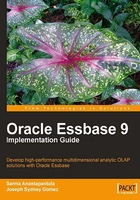
What this book covers
Chapter 1 guides you through a typical Essbase installation which includes the Essbase Agent on an analytic server, the Essbase API on the server, the Essbase Administration Services, and the Essbase Add-in for Microsoft Excel.
Chapter 2 covers Essbase database design considerations and how to apply them to a multidimensional database as opposed to the traditional row and column relational database.
Chapter 3 we begin to build in Essbase (hooray!). Using the information learned in the previous chapter we build the Essbase outline which is the foundation of the Essbase database. Instead of rows and columns an Essbase database contains dimensions and members in a hierarchical parent-child structure.
Chapter 4 dives right into loading data into your Essbase database. From user inputted data to flat file data manipulation and loading to direct database access all forms of data loading are explained and demonstrated.
Chapter 5 explains the varied and simple ways to calculate your data. Once data is loaded it is time to demonstrate one of the largest benefits of Essbase. Unlike relational databases, Essbase data can be calculated in many different ways. Instead of writing complex programs to calculate and derive data elements from existing elements or loading excessive amounts of data to derive the needed elements Essbase can calculate and derive data from a minimal amount of loaded data. Essbase has powerful yet simple to use tools that calculate the data
Chapter 6 goes over the use of the data for reporting, presentation, or data extracts to feed other systems. Simple steps explain how to create dynamic reporting abilities or user interfaces with a minimum of effort.
Chapter 7 jumps feet first into the Essbase Add-in for Microsoft Excel. As Microsoft Excel seems to have become the dominant spreadsheet program used by business today the Essbase Add-in for Microsoft Excel has evolved into a very powerful tool indeed. This is one of the main reasons Essbase is so popular today. Even the most novice end user can quickly create professional and dynamic reports with relative ease. We explain these features as well as how the addition of very little code can make the spreadsheet very powerful.
Chapter 8 we cover automating your Essbase cube. Depending on the requirements of your user community it is possible to design, build, and automate an Essbase application to where there is virtually no need for IT intervention.
Chapter 9 explains advanced techniques that can be used to keep your Essbase application running at peak performance. You know, those little things not usually covered in the user guide but learned with experience. Cache settings, server configuration, memory management are just a few topics covered.
Chapter 10 explains the Block Storage Option (BSO) and the Aggregate Storage Option (ASO) for storing data in its database cubes. For the most part this book deals with the BSO. Since the release of version 7.x Essbase has also offered the ASO. As this method of storing the data has substantial differences we felt it needed its own chapter to explain it.
Chapter 11 gives a high level view of the optional Essbase System 9 components that are available in the System 9 Suite with the Essbase database the common foundation for all the other components to launch from. With components like Essbase Planning or Hyperion Smart Office there's enough to make even the stodgiest accountant's head spin.
Appendix explains the significance of Oracle's new product Smart View.